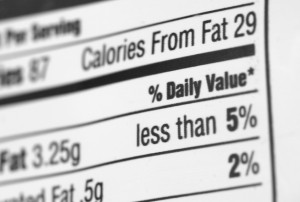You left work late and you’re rushing around doing errands. You’re hungry and you just want to get home, but you don’t have any milk or bread in the house and the kids will need breakfast in the morning.
 So you run by the grocery store. Oh, there’s a bag of cheese curls. They’re “all natural.” Into the cart they go! That frozen lasagna will come in handy later this week. You reach into the freezer case. What about dinner tonight? You head to the meat case and grab a package of ground beef.
So you run by the grocery store. Oh, there’s a bag of cheese curls. They’re “all natural.” Into the cart they go! That frozen lasagna will come in handy later this week. You reach into the freezer case. What about dinner tonight? You head to the meat case and grab a package of ground beef.
As you leave the grocery store, you feel a little guilty and a lot harried. Could you have made better decisions?
For patients of UVA’s Cardiovascular Rehabilitation and Wellness Clinic, there’s help in the form of grocery store tours led by registered dietitian Angela Spaid. These tours teach patients how to read labels and make heart-healthy choices in the aisles. What they learn “enhances people’s ability to make good decisions from the beginning — before you get home,” Spaid says.
But what if you’re not a cardiac rehab patient? You can still be heart-healthy in the grocery store.
Read the Labels
Spaid recommends her patients read the nutrition labels on packaging. This way, they know what they’re buying before they eat it. Patients on her grocery store tours are often surprised by the amount of sodium and fat in dairy products like cheese, or by the amount of sodium in soups, even those marketed as low sodium.
Here’s what Spaid says to look for on a nutrition label:
- Serving size: Looks can be deceiving: A 20-ounce soda bottle contains 2.5 servings, so if you drink the entire bottle, you’re getting 250 calories, not 100.
- Total fat: Look for foods with 3g or less of total fat per serving.
- Saturated fat: Limit your saturated fat each day by aiming for less than 1g per serving.
- Trans fats: Avoid these altogether.
- Sodium: UVA’s nutritionists tell heart rehab patients to limit their sodium intake to around 1,500mg per day.
- Carbohydrates: Check to make sure the majority of your carbs are from fiber, not sugar.
“Reading labels often seems daunting, but once you do it, then you have this laundry list of products that you know work for you,” Spaid says.
Shop the Perimeter
The produce, meat, dairy, bread and seafood aisles are generally located around the perimeter of the store. And that’s where you should spend most of your time. Fresh food is healthier than the processed foods in the center aisles, and you can always choose lowfat meats and dairy, as well as whole grains.
 Spaid also recommends patients avoid foods at the endcaps, the products placed at the end of an aisle. Grocery stores spend a lot of money on market research and they know you’ll be tempted when they place high-sodium and high-fat snack foods in those prime locations. The same goes for the checkout aisles; try not to pick up candy bars or calorie-laden sodas on your way out.
Spaid also recommends patients avoid foods at the endcaps, the products placed at the end of an aisle. Grocery stores spend a lot of money on market research and they know you’ll be tempted when they place high-sodium and high-fat snack foods in those prime locations. The same goes for the checkout aisles; try not to pick up candy bars or calorie-laden sodas on your way out.
But be careful. The seemingly healthy produce section has its temptations, too. In the summer, you’ll often see lovely displays of healthy strawberries — surrounded by endless cans of whipped cream and packaged sponge cakes.
Grocery Shopping Tips You Can Use
It certainly takes some effort to make good choices at the grocery store. Spaid advises that shoppers follow these six tips to help them navigate the experience with ease.
- Don’t go grocery shopping when you’re hungry. You’ll impulse buy and pick out the items that tend to be high in sodium and fat.
- Menu plan for the week ahead; use your menu to make a list.
- Always take your grocery list with you.
- Don’t go at peak times. Weekends are usually busy, so try to go on weekdays in the early morning or late afternoons if you can. You’ll have more time and space to read labels and make wise choices.
- If possible, don’t take your kids with you. They’ll distract you from your mission.
- If you don’t have time to make a list, look for the American Heart Association icon on food packaging. It will guide you in making heart-healthy choices.
Do Have Some Grocery Shopping Tips?
Let us know your heart-healthy grocery shopping tips by commenting on this post.
Learn More About Cardiac Rehab
Find out more about UVA’s Cardiovascular Rehabilitation and Wellness Clinic.
I wish I had a better sense for how to make a menu plan for the week. That would help me have a plan for when I do my shopping. Maybe it’s lack of imagination, but typically I simply cooked or ate whatever was around at home. I didn’t have to shop for groceries. Now I do have to get those myself and at the grocery store I feel overwhelmed. I end up not getting much and then at home not eating much. Is there a weekly menu planning website I can use?
I do much better at the grocery store if I have picked out some recipes and made a list of needed ingredients before I go. I like to pull out pictures along with the recipes (such as ones from Campbell soup found in magazines-just get the low sodium version of the soup). I’m off on Mondays, so I like to fix several things and then know I have left overs when I get home the rest of the week. Steaming broccoli or cauliflower is a quick way to get veggies while the entree is heating in the over or microwave.
I make a list ahead of time, and put the items in order of how they are placed in the store. It saves me time, keeps me on track, and gets me out before I start ogling cookies and chips!